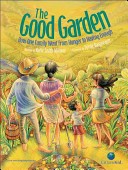
From the best-selling author of One Hen comes the inspiring story of one struggling farming family in Honduras and their journey to growing enough food to meet their needs. Based on the real story of farm transformation underway in Honduras and many other countries, this book offers children ways they can be part of the movement to grow “good gardens” and foster food security. Eleven-year-old Maria Luz and her family live on a small farm. This year their crop is poor, and they may not have enough to eat or to sell for other essentials, such as health care, school uniforms and books. When Maria’s father must leave home to find work, she is left in charge of their garden. Then a new teacher comes to Maria’s school and introduces her to sustainable farming practices that yield good crops. As Maria begins to use the same methods at home, she too sees improvements, which allow her family to edge their way out of the grip of the greedy “coyotes” — the middlemen who make profits on the backs of poor farmers. Little by little, the farms — and the hopes — of Maria and her neighbors are transformed as good gardens begin to grow.
See the review at WOW Review, Volume 3, Issue 1
- ISBN: 9781554534883
- Author: Milway, Katie Smith
- Published: 2010 , Kids Can Press
- Themes: Family, Identity
- Descriptors: Honduras, Picture Book, Primary (ages 6-9)
- No. of pages: 32

The Good Garden tells the story of one family struggling to survive on a farm in Honduras. The 11 year old daughter, Maria Luz, proudly takes over the family garden while her father leaves home in search of work. While Maria’s father is away, Maria’s new teacher models sustainable farming practices such as terracing and planting marigolds to keep the insects away. The new teacher even shares radish seeds with her to plant and harvest as a quick crop and then takes her to the market so that she can get a fair price for them rather than get swindled by the “coyotes”, the middle men that make profits from poor farmers. Eventually, Maria’s neighbors do the same and many families are able to survive and have “enough”.
The Good Garden: How One Family Went from Hunger to Having Enough written by Katie Smith Milway and illustrated by Sylvie Daigneault contains an overwhelming amount of information. The Duarte family’s story is written in such a way that the reader is drawn into the text and is able to easily understand their struggles, the steps they took to achieve the status of being “food secure,” and how they transitioned from struggling to not struggling as much. The information provided by the teacher Don Pedro Morales proved to be pivotal in their successes and powerfully shows how important education is to these communities in Honduras. Based on actual events and actual families the appendix at the end of the story provides valuable resources for extended study, photographs, ways to get into action to help, as well as, vocabulary to help one understand the text. Part of a larger collection of books to “inform children about the world and inspire them to be better global citizens” this book would make an excellent addition to any library, classroom, or home. Often students in the United States are unaware of what life is like outside of where they are and focus more in a centrist way on themselves. After reading this text one gains a strong sense of perspective when comparing how this family lives compared to how most families in the U.S. live, on the contrary though in my school district, many of my families are farmers, work in the agricultural industry, or know families that do thus making for a unique and interesting comparison.
This sounds like a very interesting story. A lot of my family members are farmers. Farming is a way of life. I believe that this would be a great book for children to read. I will have to check this book out myself.
This sounds like a really good inspirational story. It sounds like it would challenge kids to keep perservering and never lose faith in what they are doing. I think that I may go check this book out.
This book sounds like it would be a great story to read to lower SES students. They would understand the parallels of having to work to help support your family. Even though the stories take place in different countries, the struggles are the same for the students.